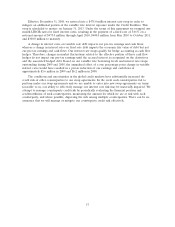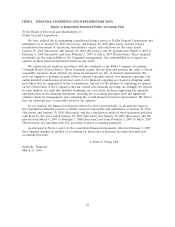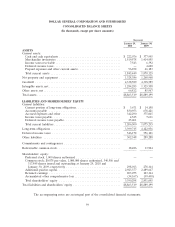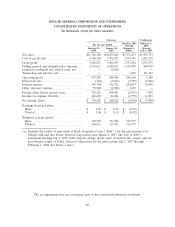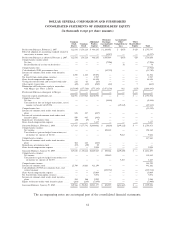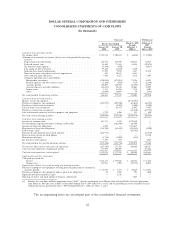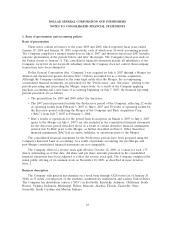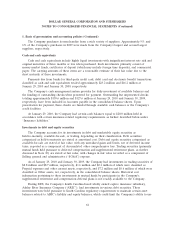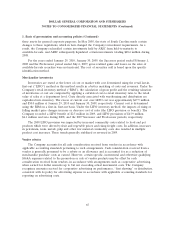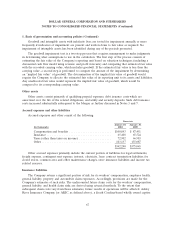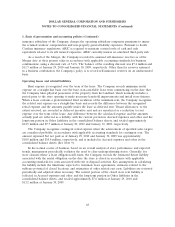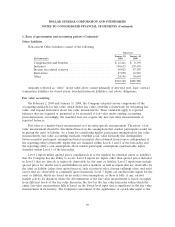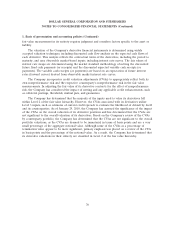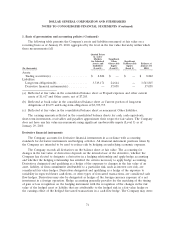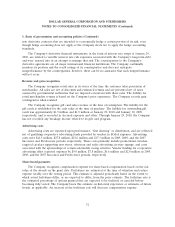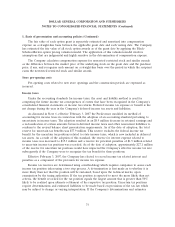Dollar General 2009 Annual Report Download - page 76
Download and view the complete annual report
Please find page 76 of the 2009 Dollar General annual report below. You can navigate through the pages in the report by either clicking on the pages listed below, or by using the keyword search tool below to find specific information within the annual report.DOLLAR GENERAL CORPORATION AND SUBSIDIARIES
NOTES TO CONSOLIDATED FINANCIAL STATEMENTS (Continued)
1. Basis of presentation and accounting policies (Continued)
these assets for general corporate purposes. In May 2008, the state of South Carolina made certain
changes to these regulations, which in turn changed the Company’s investment requirements. As a
result, the Company reclassified certain investments held by ARIC from held-to-maturity to
available-for-sale, and ARIC subsequently liquidated certain investments totaling $48.6 million during
2008.
For the years ended January 29, 2010, January 30, 2009, the Successor period ended February 1,
2008 and the Predecessor period ended July 6, 2007, gross realized gains and losses on the sales of
available-for-sale securities were not material. The cost of securities sold is based upon the specific
identification method.
Merchandise inventories
Inventories are stated at the lower of cost or market with cost determined using the retail last-in,
first-out (‘‘LIFO’’) method as this method results in a better matching of costs and revenues. Under the
Company’s retail inventory method (‘‘RIM’’), the calculation of gross profit and the resulting valuation
of inventories at cost are computed by applying a calculated cost-to-retail inventory ratio to the retail
value of sales at a department level. Costs directly associated with warehousing and distribution are
capitalized into inventory. The excess of current cost over LIFO cost was approximately $47.5 million
and $50.0 million at January 29, 2010 and January 30, 2009, respectively. Current cost is determined
using the RIM on a first-in, first-out basis. Under the LIFO inventory method, the impacts of rising or
falling market price changes increase or decrease cost of sales (the LIFO provision or benefit). The
Company recorded a LIFO benefit of $2.5 million in 2009, and LIFO provisions of $43.9 million,
$6.1 million and zero during 2008, and the 2007 Successor and Predecessor periods, respectively.
The 2008 LIFO provision was impacted by increased commodity costs related to food and pet
products which were driven by fruit and vegetable prices and rising freight costs. In addition, increases
in petroleum, resin, metals, pulp and other raw material commodity costs also resulted in multiple
product cost increases. These trends generally stabilized or reversed in 2009.
Vendor rebates
The Company accounts for all cash consideration received from vendors in accordance with
applicable accounting standards pertaining to such arrangements. Cash consideration received from a
vendor is generally presumed to be a rebate or an allowance and is accounted for as a reduction of
merchandise purchase costs as earned. However, certain specific, incremental and otherwise qualifying
SG&A expenses related to the promotion or sale of vendor products may be offset by cash
consideration received from vendors, in accordance with arrangements such as cooperative advertising,
when earned for dollar amounts up to but not exceeding actual incremental costs. The Company
recognizes amounts received for cooperative advertising on performance, ‘‘first showing’’ or distribution,
consistent with its policy for advertising expense in accordance with applicable accounting standards for
reporting on advertising costs.
65




